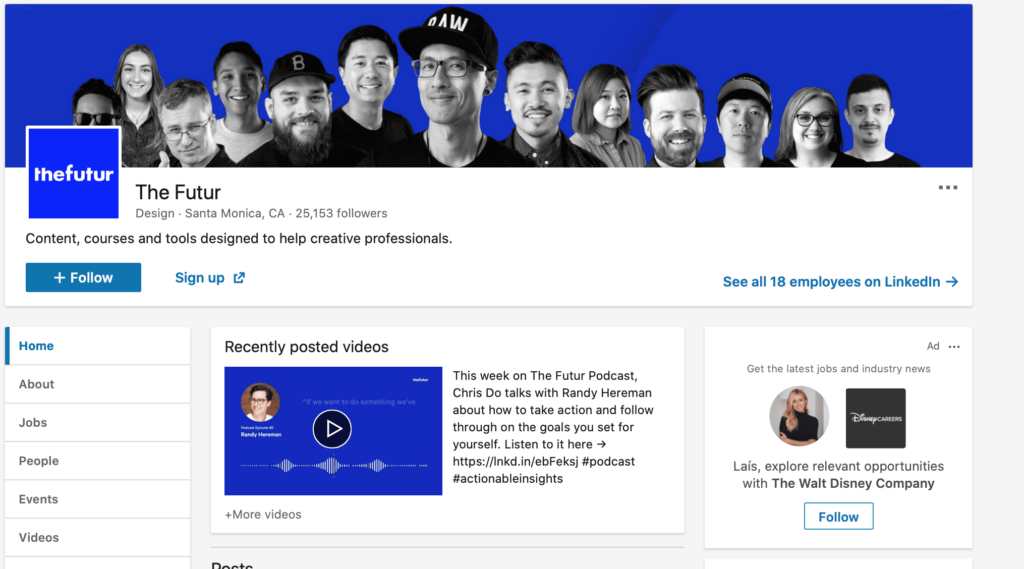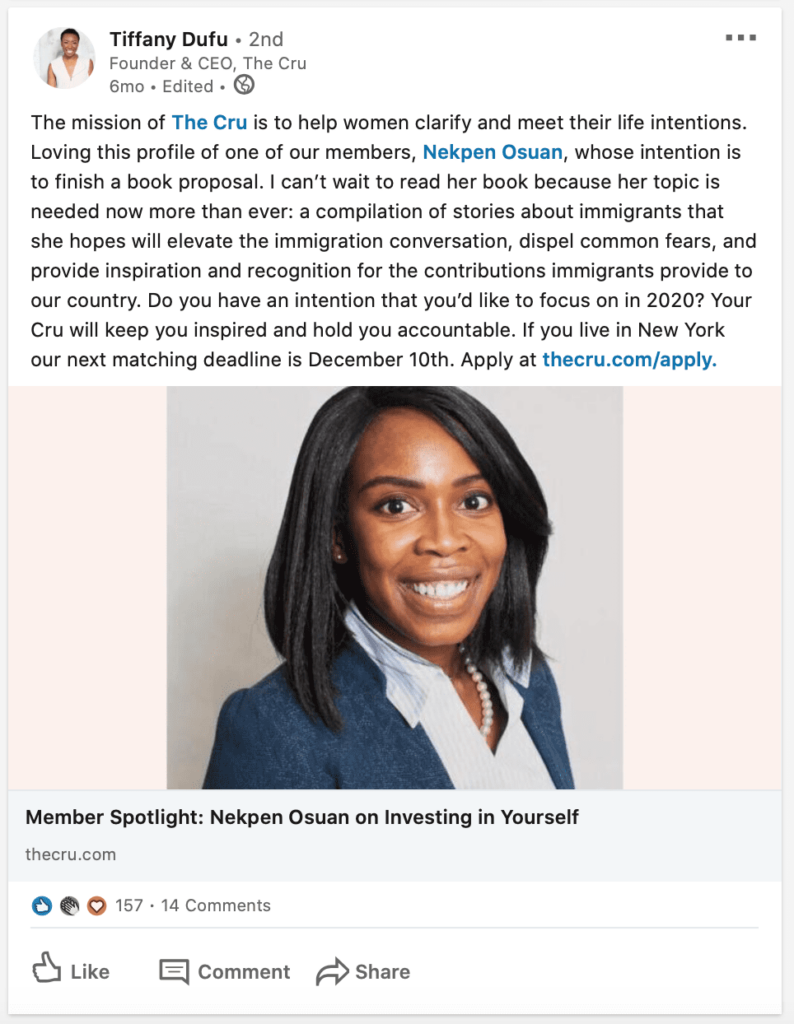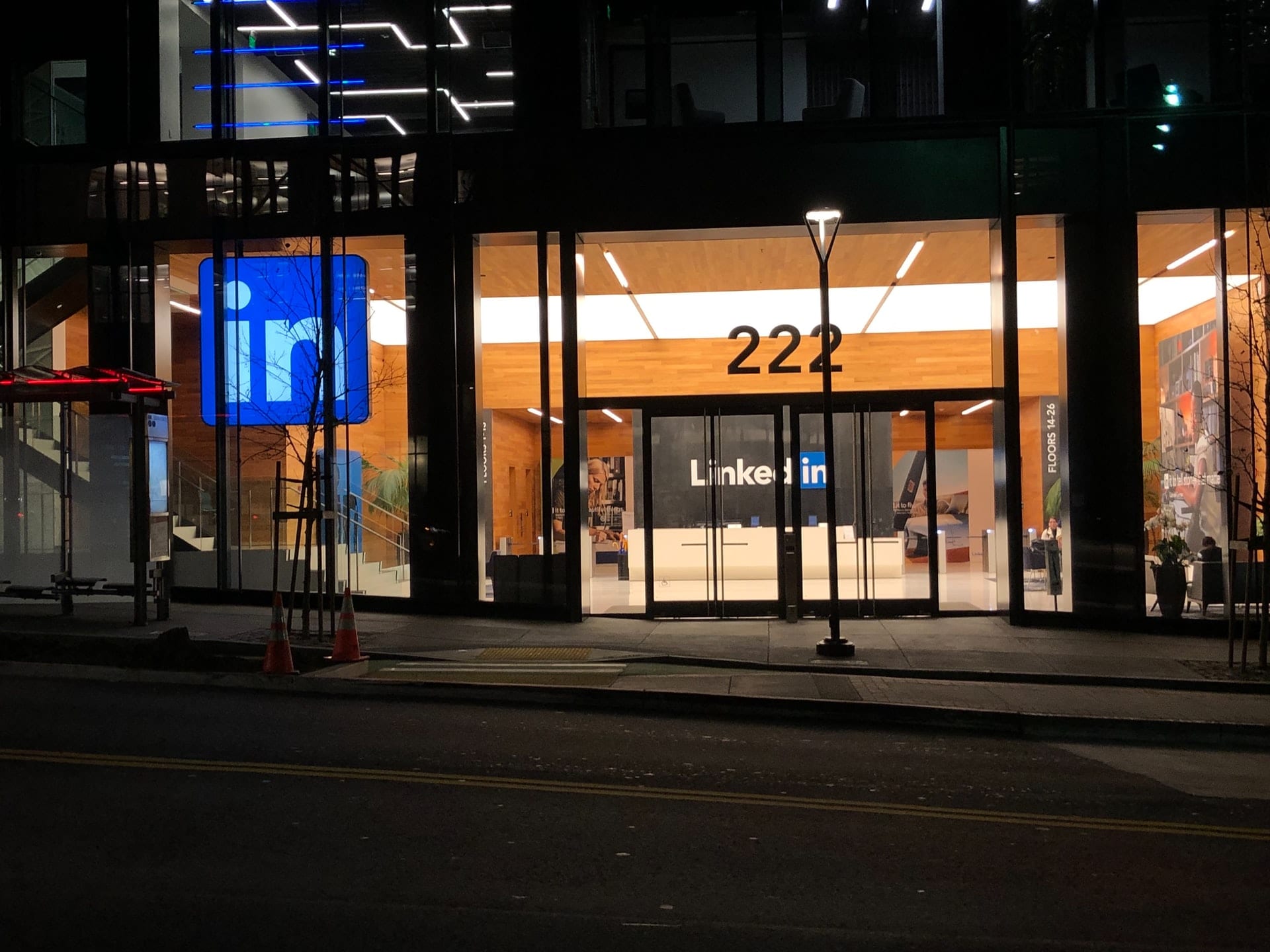
For years, LinkedIn was perceived as a platform that connects job seekers with prospective employers. Nowadays, LinkedIn is a powerful marketing tool for both big and small businesses. Just like any other social platform, there are a few tips and tricks you must follow to create a strong LinkedIn marketing strategy and stand out amongst its many users.
LinkedIn has 630 million users and more than 50 million companies are listed on the site. Their audience is more professional than other platforms, which makes it great for B2B marketing. In fact, 94% of B2B marketers use LinkedIn to share content as a way to promote their business and services.
But how exactly can you do this? Once you realize that LinkedIn is not just for sharing your work achievements, job postings, or resume, you will see that it’s the perfect place to create a solid content marketing strategy so you can reach the right people for your business.
Keep reading to find out:
4 Benefits of LinkedIn Marketing
LinkedIn is more formal than other platforms, so it’s much more likely that you’ll be posting about more serious topics and trends. But, that doesn’t mean you can’t have a little bit of fun with it.
Just like any other social media platform, you should aim to create a mix of content that showcases your expertise, personality, and point of view. It’s also a great place to engage and build stronger relationships with people who are truly interested in your content or business.
People on LinkedIn are thirsty for knowledge. They like to read more than on any other social media platform and they are much more likely to interact with interesting and valuable content for them, which makes it ideal for:
1. Networking

When you post great content or interact with users who create great content, you’re building a professional network. It doesn’t matter if your business model is B2B (business to business, which means your customer is typically another business) or B2C (business to consumer, which means your customer is a person), you can reach them all there.
Don’t mistake networking with spamming, though. There are people who will add countless connections to inflate their numbers or send people the same copy and pasted message in an effort to seem more personable. It’s important to be authentic and reach out individually to people you want to connect with rather than focusing on numbers alone.
Think about how you can improve someone’s life. This is good advice for networking no matter where you are. Sending a random impersonal message won’t get you very far but reaching out to someone with a compliment, helpful piece of advice, or mutual connection to discuss will get you a lot farther.
2. Build Brand Awareness
LinkedIn is a great place to strengthen your brand’s image. When you share valuable content, users will start to associate the content and the feeling they have when they see it with your brand. If they love your content and the experience you provide them, they will start to love your brand as well.
Sharing valuable content on LinkedIn helps to build brand awareness and establishes you and your company as an expert in your niche.
3. Build Trust
Becoming an expert and giving people what they need or want is how you create a relationship of trust with your audience. This makes all the difference when they think about hiring someone or choosing a company to work with.
The people you’ve built trust with are also primed to be your most loyal customers because they respect you and know you have good intentions for them. I can say that the clients I get coming from my social media pages are my absolute favorites. I don’t need to prove anything to them, they already know they can trust me!
4. Increase Lead Generation
LinkedIn’s audience is super engaged. In fact, Hubspot found that LinkedIn visitors (LinkedIn users who visit your website) convert 277% more than Facebook and Twitter users. This is an impressive number. So, if you want to increase your lead generation, it might be worth your time to include LinkedIn in your marketing strategy.
How to Use LinkedIn to Promote Your Business in 12 Easy Steps
The best way to use LinkedIn to promote your business is through effective content marketing. As with every social media content marketing strategy, it needs to be well thought out and planned. You need to think about your business, your goals, and your audience before you start creating and posting content.
If it seems too complicated, don’t worry. We will tell you exactly how to do it in 12 easy steps!
1. Define Your Brand Persona
Here’s a harsh reality: most people don’t like to plan. They like to dive right into something without giving it a lot of thought first. Sometimes, it works out but when it comes to something as serious as your business strategy, I urge you to slow down and start with some pre-planning.
The first step really should be to define your brand persona. This is a vital part of marketing, and it can also be quite fun!
The goal here is to imagine your brand as a person and attribute characteristics to it. Ask yourself how you want to be seen by your audience. What is your brand like? What words describe it? Happy, open-minded, honest, hopeful, intellectual, lively, outgoing, self-confident, sophisticated?
While you’re doing this, it’s also interesting to define what your brand isn’t like. This helps you have more clarity on how you can best communicate with your audience. Having these boundaries set up right out of the gate makes it easier for you to create content on LinkedIn that feels true to your brand.
2. Know Your Audience
You can’t post content to every platform so knowing your audience helps you narrow down the sites you need to be most active on. If your audience is mostly pre-teens or senior citizens, LinkedIn is probably not for you. But, if your target audience is on LinkedIn, it’s time to examine what kind of content that audience wants to see.
In the beginning, you might not know exactly what will work best. You can try looking at your competitor’s posts to see what’s working and what’s not working for them. If that doesn’t work, try thinking like your target audience. Ask yourself, “What would I like to see here if I were them?”
With this insight, you can start creating a few different kinds of content to make sure you have variety. Test and see what works best. Do some posts that are just text, then do some with images. Maybe you can even create a simple infographic in Canva to share some main ideas regarding a trending topic.
No matter what you decide to do, you’ll want to make sure you’re creating content that’s relevant to your target audience and provides useful information about your niche. Then, just analyze your numbers and see which of your posts performed best. This will help you create the kinds of posts that resonate with them the most.
3. Set Goals
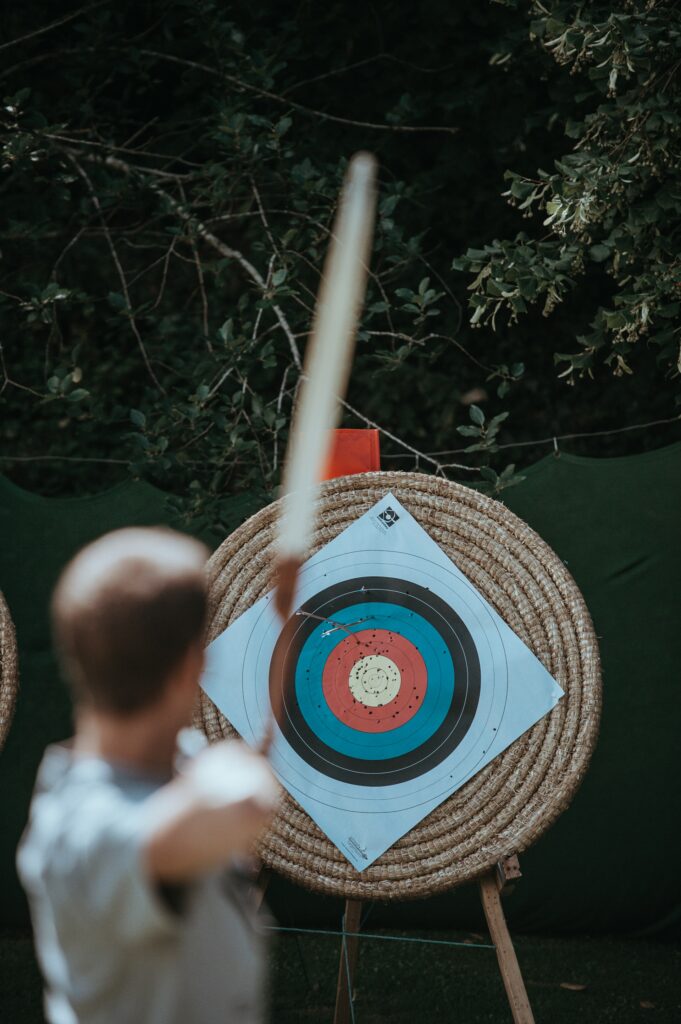
Setting goals is a key part of any social media strategy. It’s obvious to me now, but I didn’t always think this was the case. It’s basically impossible to understand if your marketing strategy is successful if you don’t have goals. How else are you going to measure your results or know if your time was well-spent?
There’s this quote from Alice in Wonderland that pretty much says it all:
“Would you tell me, please, which way I ought to go from here?” “That depends a good deal on where you want to get to,” said the Cat. “I don’t much care where—” said Alice. “Then it doesn’t matter which way you go,” said the Cat.
Basically, if you don’t have goals, you won’t get anywhere because you don’t know where to go. The content you create is going to be pointless, as well as everything you do in your marketing strategy. In the end, you’ll be frustrated because you won’t have anything to show for your time and effort.
Create 3-5 goals for your LinkedIn marketing strategy. You might want to use LinkedIn to increase brand awareness, increase community engagement, generate more leads, increase your website’s traffic, etc.
Once your goals are set, you can define some objectives within those goals. These objectives will help you measure the success of your LinkedIn marketing strategy.
Let’s say your goal is to increase brand awareness (get more people to know your brand) your objectives could be:
1. Get 200 new subscribers on my newsletter in the first quarter from LinkedIn.
2. Increase my website’s traffic by 10% with users coming from LinkedIn in Q1.
3. Get 20 likes on every LinkedIn post during Q1.
Once your goals and objectives are clear, you’ll be able to plan your marketing strategy to achieve them.
Need help creating your content marketing strategy? Click here to access our “Social Media Content Marketing for Small Businesses” email course!
4. Optimize Your Profile
This is a very important step in your LinkedIn marketing strategy. As a small business, the idea is to use your own personal profile to promote your business. I know that most blog posts say you should set up a company page. However, I’ve talked to some of my friends and researched blogs written by some LinkedIn experts, and they all said that posting with your company profile is not the best way to promote your business.
The reason behind this? It doesn’t seem as if company pages on LinkedIn get as much attention as personal profiles. If you’re just starting out, you’ll probably get way more ROI if you use your personal profile to promote your small business.
Write your LinkedIn Profile
Even if you already have a personal profile on LinkedIn, you shouldn’t just start posting. Your first goal should be to set up your profile to attract your ideal clients. So how do you do that?
For starters, you should create a client-focused profile. A huge mistake most people make when setting up their profile is they create a huge list of their achievements and professional history.
This may seem counterintuitive, but your profile should actually be addressed to your clients and their needs rather than serving as a digital resume for you. At the end of the day, people are not as interested in you as you think they are. They are more interested in what you can do for them. So make it clear on your profile!
Use the Right Keywords
Assume that people don’t already know you. What would they type in LinkedIn’s search bar in order to find you? The words and phrases that you come up with would be your keywords.
For example, say someone is looking to hire a Pinterest expert. Chances are, they will type “Pinterest expert” in the search box to find someone to work with and get to know more about their business and what they do.
If your profile has a good description and uses targeted keywords related to your niche, the chances your ideal customer will find you are so much better.
Update Your Photos
You should always use professional photos on LinkedIn. For your profile photo, it’s best to use a professional headshot, or if you don’t have one, a well-lit photo of yourself from the shoulders up. Your cover photo should be professional as well. Try to use something that’s not overly distracting in your brand’s colors.
Fill In Your Name
On other social media platforms (like Pinterest) you can add keywords to your name field. However, on LinkedIn, you are not able to do that. Adding anything to the name field other than your name violates LinkedIn’s Terms of Service, which means they can restrict your account.
Fill In Your Headline
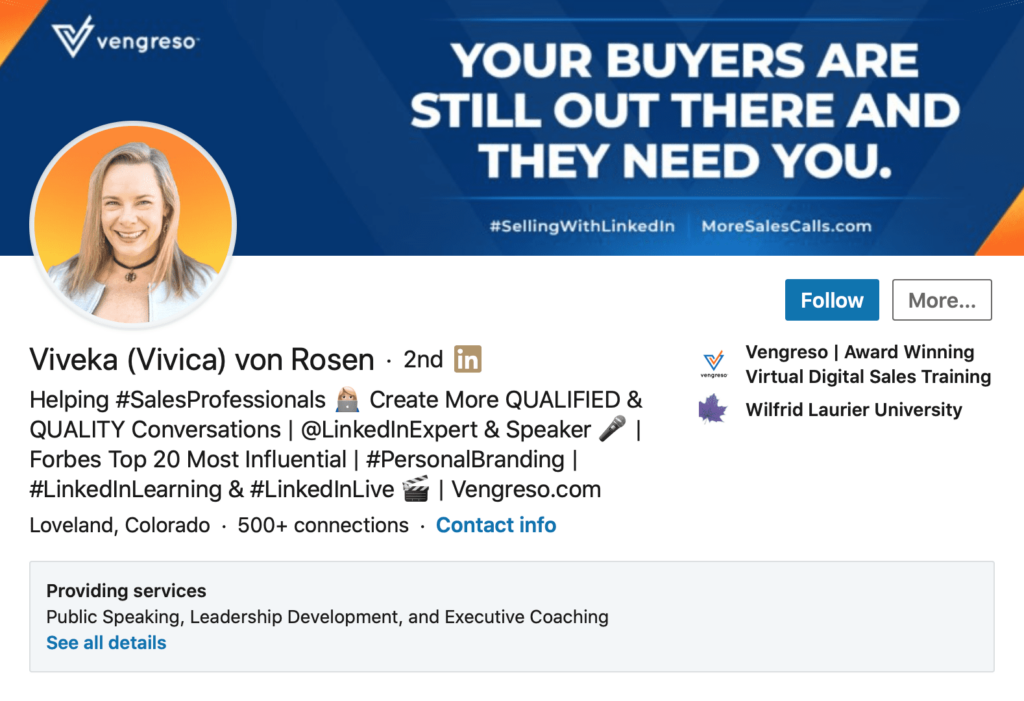
You get 120 characters for the headline, so you want to give this some thought. You want to create a captivating headline that shows potential clients what they can expect from you. Include one or two keywords in your headline and tell people what you do for them. Remember, they don’t know you yet and this is your chance to make a really powerful first impression.
Write Your About Section
The first sentences of your About section are the most important. These are the sentences that will make someone decide whether they should click “See More” or not. So, just like your Headline, you will want to make sure you’re making people excited and curious about you and your work.
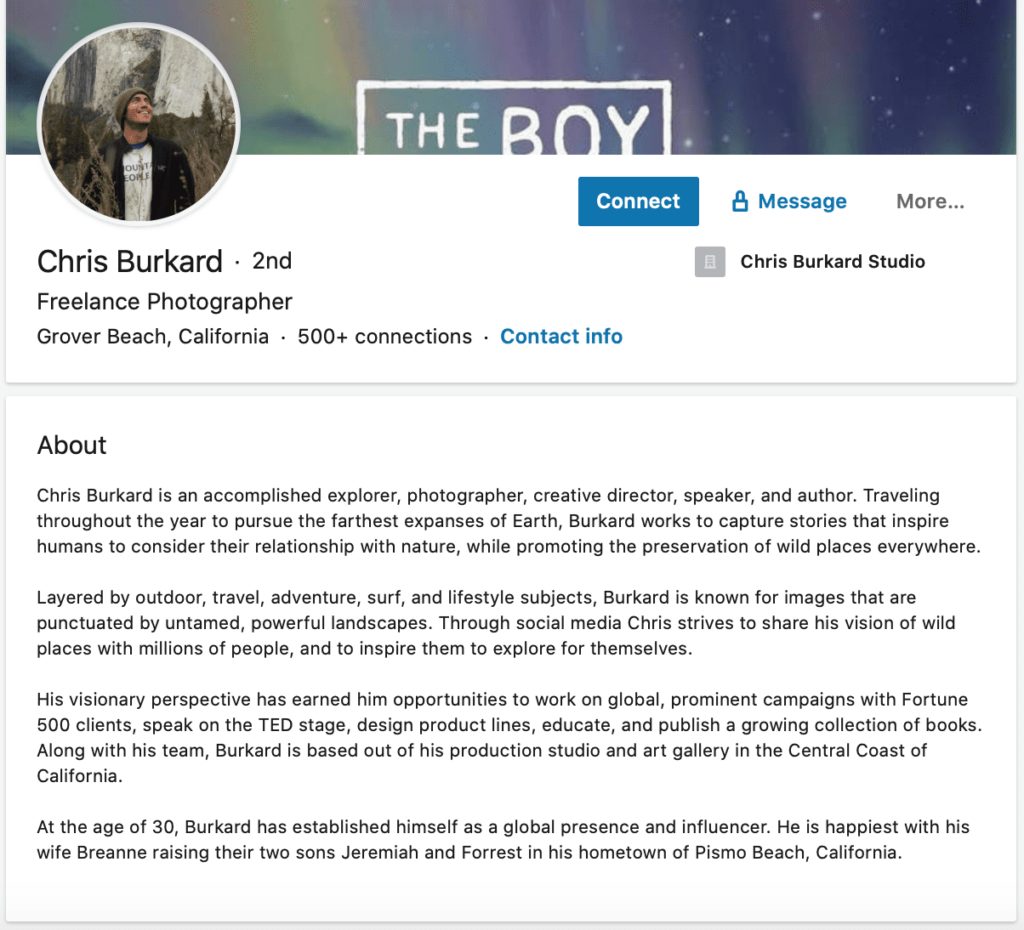
Set Up Your Vanity URL
LinkedIn automatically creates a URL for your profile page, but it will be randomly generated. You can choose to set up a vanity URL where you can replace the random URL that LinkedIn gives you with something that’s easier to remember.
Take advantage of this option! The last thing you want is to have a really complicated URL that doesn’t allow people to easily find you.
5. Create Your Company’s Page
In step four, I said that it’s not ideal to use your company’s profile as your main channel if you’re a small business. However, you should still go ahead and set up your company’s page even if you’re not going to be regularly posting from it.
Setting up your company’s page allows you to add it to your professional experiences section as a clickable link. It also allows you to tag the page in your posts. When people want to know more about your company, they can head to your company’s page.
Once you have employees, they can also link to your company in their work experience section and post about your business to create more brand awareness.
If you want to create a Company Page, here’s a great tutorial from Digital Shift to help you with that.
6. Connect with People
A social network is nothing without connections. Connecting with people who are interested in what you have to say is essential.
So connect with people you already know, but also with people who are interested in your niche. Search for them online, on LinkedIn, and send them a connection request.
When you do this, be sure to create a customized message. Introduce yourself and say something nice about them, too. Let them know how much you would appreciate the chance to connect with them and show them what you can give them in exchange.
Keep in mind: if you have a cool profile and nice, professional photos they will take you way more seriously.
7. Write Articles About Your Niche
Writing articles on LinkedIn is a great way to get started and establish yourself as an expert in your niche. When people see that you’re writing about topics they want to know more about or sharing interesting content, they will start to trust you and your brand more and follow along for more of your content.
When you create content that resonates with people, they’ll start to share it with their own networks, which means you will show up in people’s feeds you wouldn’t normally have a chance to connect with. Even if all they do is “like” your post, it will show your content to their connections with a message like, “Sara Sullivan liked this post.” Soon, you’ll start to make connections based solely on the content you post.
When you take the time to write good articles, you’re giving LinkedIn’s users the chance to know more about you and see you as an authority. This is what builds good relationships.
Just remember, the articles and posts you create should be based on your brand personas. Don’t just create content to create content. Your goal is to put information out there that will attract the right people. So whenever you come up with an article idea, ask yourself two questions: 1) What’s the goal of this content? 2) Is this content interesting to the people I want to serve?
Read more: How to Create a Social Media Plan for Small Businesses
8. Write Short Posts
LinkedIn status updates are a great way to share interesting insights with your audience without having to invest a ton of time or get too deep into any one topic.
For example, your strategy might be to post one article per week and two or three status updates per week. You can even use the articles you create to make your status updates. Just pull a line from the article and talk about it a little more in-depth.
This is an easy way to be more active on social media, interact with your audience, and start conversations with them.
9. Add a Call to Action
If you want people to interact with you, tell them exactly how to do so. If you don’t do this, they probably won’t do it. You might want to explicitly let them know that you want to connect with them and get their thoughts on something. Or, you can just ask them to share your content with people they think would be interested in it.
Once you hook someone in with your content, it’s very important that you keep them engaged by telling them what action you want them to take. You don’t want more passive readers. You want people to connect, sign up for your email list, sign up for a free consultation, or do some other action that’s mutually beneficial.
That’s the key, though. You have to give them value in return. If you’re asking them to follow you on another platform, show them the benefit of doing so. Outline how amazing your email newsletter content is. Give them a free ebook in exchange for their contact information. Get creative with it!
10. Interact With Other Users
If you want people to interact with your content, you also have to interact with theirs. Show your appreciation, share your thoughts about their post, show them how much you like what they are creating. When you leave positive and personal comments, people will usually reciprocate.
If people don’t know you yet, they won’t trust you much. You have to build that trust by consistently showing up and offering your perspective.
When you leave valuable comments, people will be curious to learn more about you, they’ll click through to your profile and maybe even head to your website. It’s an easy way to build credibility.
Here’s a piece of advice, though. Try to interact with other people’s posts only on days that you haven’t posted anything. Interacting with other people’s posts after you’ve posted something on your own page will “kill” it, so to speak. LinkedIn will start showing people your new interactions instead of your new content, which will bury your post.
11. Be Consistent
Like any social channel, succeeding with your LinkedIn marketing strategy requires consistency more than almost anything. Consistency is what builds trust and relationships. Consistency is what shows people you are there for them.
Consistency is what shows your followers that you plan to provide more value than you take.
So, be consistent in providing content that addresses your target buyer’s concerns and problems. Create content that inspires them. Find amazing content on the internet that you can share to make their lives easier. Everything you do should indicate that you have their best interests in mind.
Of course, knowing your audience inside and out will make it so much easier to do this. When you really understand what your audience needs, you’re going to find that everything else comes much more effortlessly as well.
12. Go Slow
It’s natural to want to rush into a LinkedIn marketing strategy, but this is when you will start to lose sight of the value you want to provide. This is when the spammy posts start to creep in, or posts stop coming altogether. Rushing will kill your results before they even happen.
Instead, set aside some time every day, or every other day, to connect with the right people, reach out to them individually, and create content that resonates with them. Every so often, put together a thoughtful pitch (you are running a business after all) but make sure it still serves your people and meets them where they are at.
A good rule of thumb is to create 80% of your content as a “give” and 20% as a “take.” This means, more than three-quarters of the time you are sharing valuable, educational, or inspirational content and once in a while, you’re asking them for a sale. Keep this ratio in mind and you won’t come across as pushy, which is always a good thing!
Did you like these tips?! Then don’t forget to save the image below in your “LinkedIn Marketing Tips” board on Pinterest! Also, check out our Pinterest page and follow us to get daily updates + digital marketing and social media tips for small businesses!
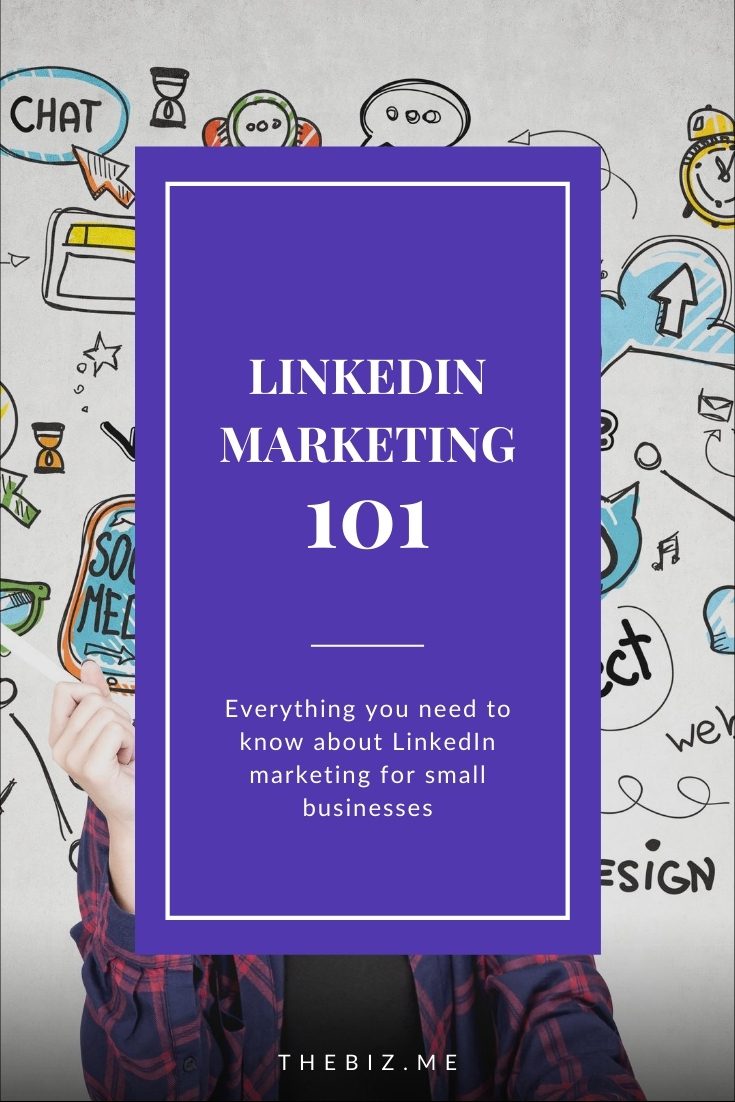
We can’t wait to see what you do. Please tag us using the hashtag #GrowingMyBiz so we can see and share your work!
